As the world grapples with an energy crisis fueled by climate change and a growing demand for sustainable energy sources, the need for efficient hydrogen production has never been more critical. A research team led by Professor Chen Changlun at the Hefei Institutes of Physical Science has made a profound impact on this quest by developing advanced cobalt-doped nickel hydroxide bipolar electrodes, which promise to enhance the efficiency and longevity of two-step water electrolysis methods. This innovative approach not only addresses the limitations of traditional alkaline electrolyzers but also underscores the vital role of materials science in the transition to cleaner energy.
Breaking Down the Challenges of Traditional Electrolyzers
Traditional alkaline electrolyzers are hindered by several significant drawbacks, including their incompatibility with fluctuating renewable energy sources and issues with hydrogen and oxygen mixing under high-pressure conditions. This situation severely limits their practical applications in real-world energy systems. However, the two-step water electrolysis process devised by Professor Chen and his colleagues offers a novel solution by entirely isolating the hydrogen and oxygen production phases. This separation negates the necessity for expensive membrane separators, thereby potentially lowering production costs.
Yet, the rafters of this innovation rest upon the shoulders of high-performance bipolar electrode materials and innovative cell designs. While nickel hydroxide electrodes have been widely employed, their inherent flaws in charge stability and buffering capacity have hampered their effectiveness. This underscores the urgent need for advancements that can push the boundaries of current technology.
The Ingenious Role of Cobalt Doping
In a bold departure from conventional methods, the research team’s innovative use of cobalt doping in nickel hydroxide bipolar electrodes significantly improved the overall conductivity and electronic storage capacity. The one-step electrodeposition technique employed allows for the seamless integration of these enhancements, thus preventing unwanted parasitic oxygen production during the hydrogen generation phase. Such meticulous refinements elevate the efficiency of water electrolysis to unprecedented levels, setting new benchmarks in this competitive field.
Furthermore, the creation of non-noble metal catalysts, including molybdenum-doped nickel-cobalt phosphide and plasma-induced iron composite cobalt oxide bifunctional electrodes, adds another layer of robustness to this revolutionary technology. These catalysts not only exhibit heightened durability but also facilitate the energy conversion process, enabling simultaneous ease in hydrogen and oxygen production by merely switching the direction of the current flow.
Transforming Energy Solutions with Non-Thermal Plasma Technology
The application of non-thermal plasma technology to produce nitrogen-doped nickel-cobalt layered double hydroxide (LDH) electrodes represents a transformative approach to overcoming the challenges related to charge capacity and stability. By enhancing the conductivity of these electrodes, the researchers have paved the way for efficient hydrogen production methodologies, which could revolutionize sectors that require reliable energy storage solutions, such as 5G base stations and large data centers.
As Professor Chen remarked, the performance benchmarks established through this research align with global standards, marking a significant leap toward industrial-scale implementation. This groundbreaking work not only amplifies the potential of hydrogen as a clean fuel source but also positions it as a cornerstone in our collective ambition for sustainable energy futures. By addressing the frailties of existing technologies and innovating at the material level, Professor Chen and his team are catalyzing a paradigm shift in hydrogen production that is both timely and essential for our planet’s future.


Leave a Reply